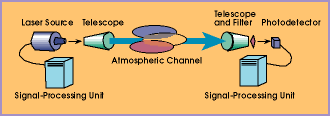
Laser Links Depend on the Weather
Breck Hitz
Researchers at Ben-Gurion University of the Negev in Beersheba, Israel, have performed a mathematical analysis of the wavelength-dependence of atmospheric interference on free-space optical links. Their results will affect the wavelength of commercial links that become available in the future.
Free-space optical links compete with both fiber optic cables and radio-frequency communications. The advantages of free-space optical links over the latter systems include the absence of a licensing requirement and of radio-frequency radiation hazards, and their larger bandwidth, smaller size and lower power consumption. Fiber optic links share all these advantages, but their major drawback is the requirement to dig up streets and to destroy walls to install the optical cables. Free-space links eliminate that problem, but are subject to atmospheric disturbances between the transmitter and receiver.

Researchers mathematically simulated the performance of an optical wireless communication system for short-distance terrestrial links at various wavelengths and in various atmospheric conditions.
It has been recognized that long wavelengths are less susceptible than visible and near-IR links to atmospheric disturbances, but the scientists wished to quantify this superiority. They analyzed kilometer-long links subject to the systemically measured atmospheric conditions at international airports in New York and San Francisco.
They confirmed the superior performance of long-wavelength (9- to 13-µm) systems but found that an advantage exists only when the atmospheric attenuation is moderate, such as in conditions of light haze or fog. When the atmosphere is clear or when it is highly attenuating, the performance of long- and short-wavelength systems is identical. Also, in situations where background noise limits system performance, the advantages of long-wavelength systems diminish because of the greater background radiation at longer wavelengths.
Averaged over all atmospheric conditions in New York and San Francisco, a system operating at 10 µm will experience one-half the downtime of a system operating at 785 nm or 1.55 µm, according to the scientists' calculations. Specifically, a 10-µm system will have 99.8 percent availability, and the shorter-wavelength systems will be available 99.6 percent of the time.
Whether this improved availability is worth the difficulty and the expense of liquid-nitrogen-cooled detectors and quantum-cascade lasers is a question that the marketplace will have to answer.
Published: September 2003